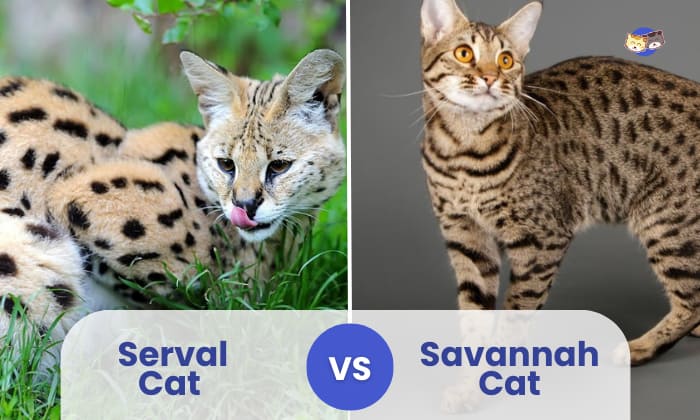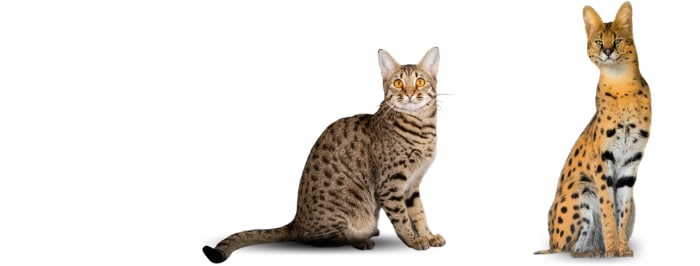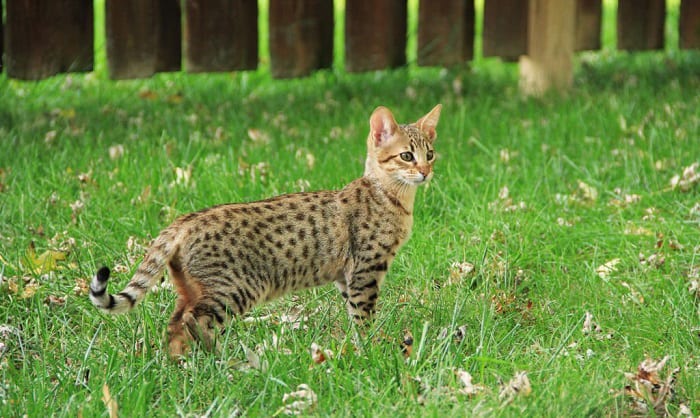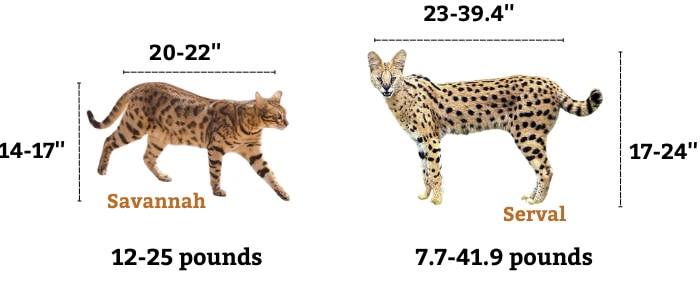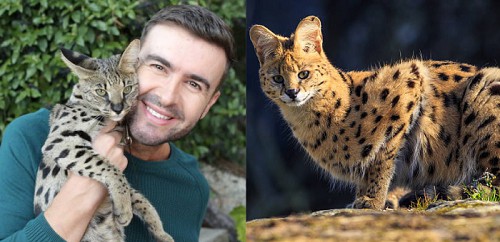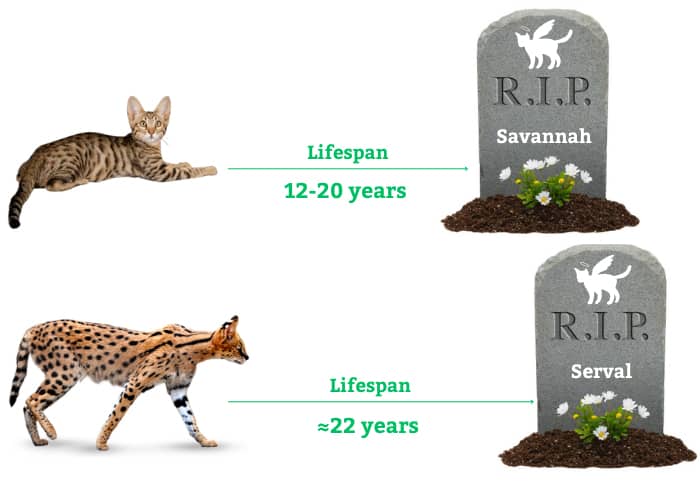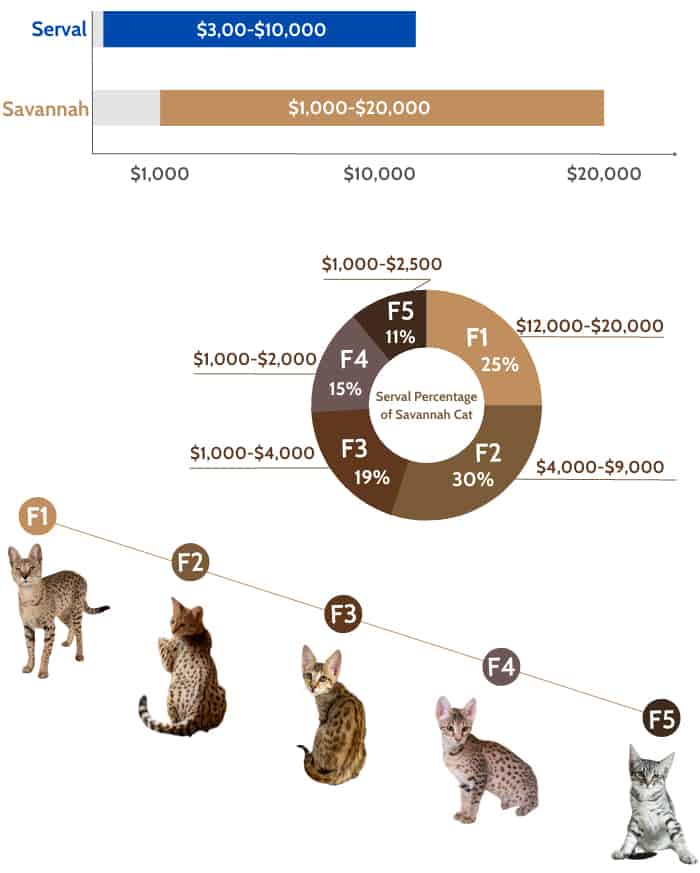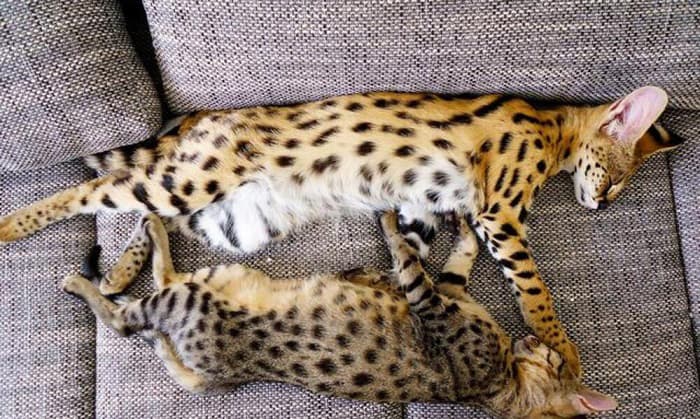Crossbreeding feline breeds sometimes results in cats that look the same yet different. Among such breeds are Serval and Savannah cats.
These breeds feature uncanny similarities, from their patterns to their facial features. If you do not have a keen eye, chances are you will mistake one breed for another.
This post will help you differentiate between the Serval vs Savannah cats. If you’re planning on adopting any of these breeds, we’ll also discuss the pros and cons of having one.
| Savannah Cat | Serval Cat | |
| Appearance | Features a number of color variations due to their domestic ancestors | Has a yellow to orange-brown coat with black spots |
| Cat Size | 20 to 22 inches in length and 14 to 14 inches high | 23.6 to 39.4 inches long and 17 to 24 inches high |
| Personality And Behavior | Tame, playful, and good with people | Aloof and does not enjoy being cuddled |
| Lifespan | 12 to 20 years | 22 years |
Table of Contents
Introducing The Serval Cat
A Serval cat is a wild feline native to the African savannah. They have long and powerful legs, spotted coats, and small and slender bodies.
Servals are famous for their distinctive long legs that give them exceptional jumping abilities. In fact, these wild cats can leap as high as 10 feet.
The fur of Serval cats ranges from orange-brown to yellow. It has black spots and white all over its body, except for its belly, which is covered in white fur.
As Servals are wild animals, up to 20 US states prohibit people from keeping them as pets. So, if you plan to bring this feline home, checking whether it is legal in your state is crucial.
Pros And Cons Of A Serval Cat
What You Need To Know About The Savannah Cat
On April 7, 1968, feline breeders first created the Savannah cat by crossbreeding domestic cats with the wild African Serval. The resulting kitten had the size and appearance of the Serval cat and the tameness of common house pets.
Simply put, the Savannah cat is basically a domestic Serval cat. It has almost all the physical appearance of the Serval, including the spotted coat, long legs, and pointed ears. However, its face looks tamer than its wild ancestor.
Although this breed is quite controversial, The International Cat Association accepted the Savannah cat as an official breed in 2012.
If you’re wondering, “Where do Savannah cats live,” the answer would be in common households, just like most domesticated cats.
The Pros and Cons of a Savannah Cat
Savannah Vs Serval: the Differences
1. Appearance
As Savannah cats are related to Serval cats, their appearance is very similar. The only difference is that the latter is larger, as the former has domestic ancestors.
Savannah cats also have more coat colors, which they got from domestic cats. While they are mostly yellow or orange-brown with black spots, Savannah cats can also be black, silver-spotted tabbies, or brown-spotted tabbies.
2. Size Comparison
Savannahs are approximately 14 to 17 inches high and 20 to 22 inches long. They also have an average cat weight of 12 to 25 pounds.
How big do serval cats get? A Serval, full grown, has a cat height of 17 to 24 inches and a head-to-tail length of 23 to 39.4 inches.
These wild felines also weigh more, as they are 7.7 to 41.9 pounds on average.
3. Personality And Behavior
Savannahs and Servals have somewhat similar behaviors, as they are related to each other. But since Savannah felines are domesticated, they are tamer, more playful, and adventurous. They have the socialization abilities of common domesticated cats as well.
However, these cats still have the instincts of wild animals. They have strong hunting instincts, making them unsuitable for people who are also taking care of small pets like hamsters.
Meanwhile, Serval cats are solitary animals. In the wild, they prefer to live and hunt alone, only interacting with other Servals during the mating season.
If you are planning to care for a Serval cat, one thing worth noting is that they have no interest in socialization. Therefore, they may not tolerate being stroked or cuddled.
4. Lifespan
When well taken care of, Savannah felines can live for 12 to 20 years. They are a relatively healthy breed and are not prone to any health conditions.
Serval cats live a longer lifespan than Savannah cats and most house cats. This wild cat has an average lifespan of approximately 22 years.
4. Cost Comparison Between Servals and Savannahs
Serval cats cost $3,00 to $10,000. This price range depends on gender, age, breeding, and where you are getting the feline from.
If your Serval comes from a reputable breeder or has a great bloodline, expect its price to be on the expensive side. Male Servals are also more costly than female ones.
On the other hand, the value of Serval Savannah cats depends on their Serval percentage. The closer their bloodline to their Serval ancestors is, the more expensive they are.
For instance, an F1 Savannah, a direct descendant of a Serval cat, costs $12,000 to $20,000. Take a look at the table below to have a better idea of a Savannah cat’s price range:
Generation
Cat Price
Serval Percentage (Approximate)
F2
$4,000 to $9,000
30%
F3
$1,500 to $4,000
19%
F4
$1,000 to $2,000
15%
F5
$1,000 to $2,500
11%
Which Feline is a Better Pet?
Savannah cats are undoubtedly better than Servals. The primary reason is that these felines are bred for domestic households. As such, they can interact with people, just like common domesticated cats.
Servals, on the other hand, are wild animals. Therefore, they should stay in their natural habitat and not with humans. These felines also have aggressive tendencies due to their wild instincts.
What Feline Should I Choose?
If you plan to bring an exotic feline home, a Savannah cat is better than domesticating a Serval due to its better temperament. The breed also has the socialization skills of a common household cat, so caring for it is also similar to tending to a standard feline.
Meanwhile, Serval cats are hunters that need a huge environment to exercise their physical strength. When kept in a home, they cannot act like they typically do in the wild. As a result, these wild felines will have a poor quality of life when kept in homes.
Legal Considerations When Getting A Serval Or Savannah Cat
The legality of owning a Serval or Savannah cat varies by state, city, and county. Some states allow exotic pet enthusiasts to care for these felines as long as they have proper permits and licenses.
As a caretaker, your state may also require you to get liability insurance or a special permit for these cats. However, other states prohibit owning a Serval or Savannah cat entirely, regardless of whether you have a permit.
So, when planning to get either of these exotic felines, it is crucial to research and understand the laws revolving around their ownership. You can refer to the pictures we included to learn where these breeds are legal.
Conclusion
Serval vs Savannah cat – regardless of which feline you choose, one thing worth noting is that these animals have wild instincts. Therefore, they have unique behavior and needs, which makes them not suitable pets for everyone.
When planning to acquire either of these cats, ensuring you can provide them with a suitable home is crucial. If you are unsure whether you can tend to the needs of these exotic animals, you may be better off with a regular domesticated feline.

I am Amy Sawy, a Doctor of Veterinary Medicine (DVM) graduate from the University of Kansas. y husband, Dr. Plummer, and I own a veterinary clinic in Phillipsburg, Kansas. In addition to my professional background, I am a devoted pet owner myself, with a household that includes dogs, rodents, and most notably, cats – a total of five felines in my home.
In 2020, I joined an organization as a professional writer, leveraging my experience and collaborating with my team to deliver the most valuable information for your cat’s care.


